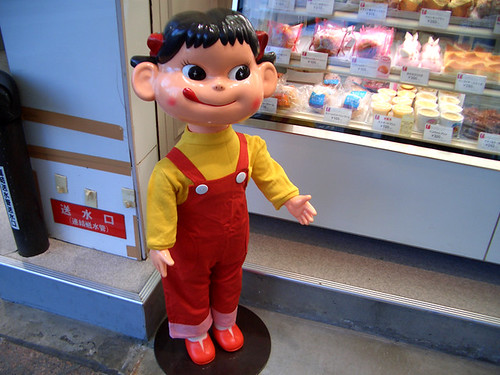
The
kawaii (= cute) world of Japan is a very positive dimension of happiness, beauty, bunnies, rainbows and ribbons. And not just something that contains characters, but also an aesthetic approach that appeals to your heart, with a rather feminine touch and usually a soft design that makes you go, "Awwwww, that's so CUUUTE". Girls wearing aprons and a hat in bakeries, colourful pictograms on bus signs, the way a piece of chocolate cake is wrapped, bundled and delivered.
It's all cute -- like we're all in kindergarten playing post office or in a kids' TV programme. The process of doing something becomes an iconic action with all its instruments and processes, which is something the Japanese love: rules, regulations and prescribed actions so you're safe from doing something out of order.
And the images of
kawaii always work as an eye opener for Scandinavian people living in their sterile, safe and generically-designed world. I could write a whole book on the
kawaii phenomena. It's such a deep conversation topic if you really start digging in, but I'll just touch the surface here regarding characters and food in Japan.
In 2005 I quit my job, rented out my apartment and moved to Tokyo.
I was struck with feelings of ecstasy and wonder when stepping onto the streets of Japan for the first time. Could such a beautiful, positive world really exist in our time?
Little animals made of sugar. The shop sign calls them "birthday mascots".
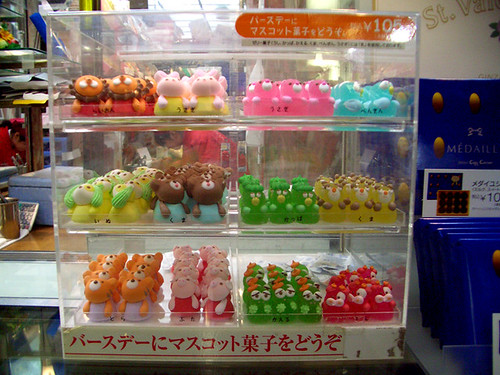 Game arcade in Tokyo: giant transparent plastic blobs contain cute little mobile straps and figurines.
Game arcade in Tokyo: giant transparent plastic blobs contain cute little mobile straps and figurines.
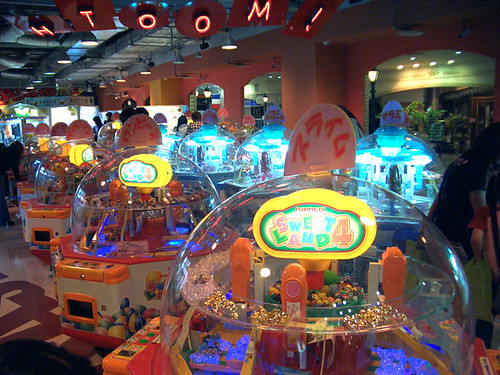 Mitaka, Tokyo: cute pink lamps hanging from all lamp posts.
Mitaka, Tokyo: cute pink lamps hanging from all lamp posts.
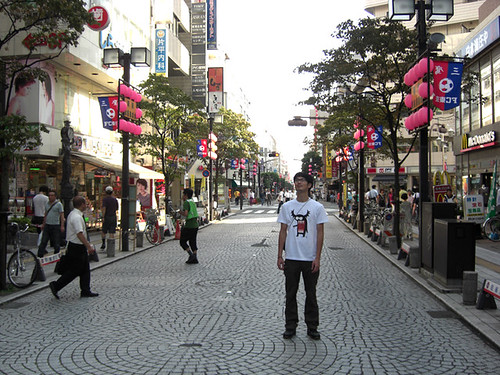
The first few months in Tokyo went by like a breeze. As a character designer by profession, it was truly magical to experience every morning -- like walking to school on a fun ride in a cottoncandy dream. Every time you walk into a convenience store you are greeted by a happy characters on product after product. Cute and delicious: that's what the Japanese like.
Nakano, Tokyo: notice the big billboard for English school NOVA featuring a pink rabbit with a bird's beak.
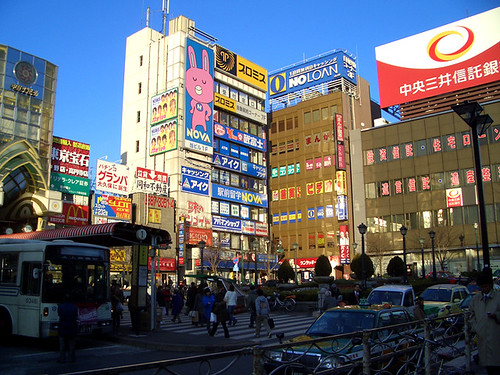 Girls dressed as the Pikachu in Harajuku.
Girls dressed as the Pikachu in Harajuku.
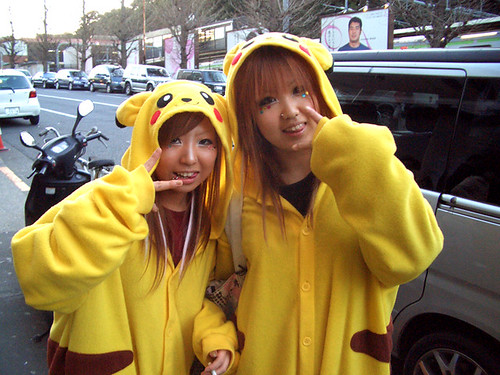
There did not seem to be any deep meaning in walking around like this, except that they were just bored.
Super famous candy character Peko-chan ("peko-peko" means "starving" in Japanese).

Connecting cuteness with food has the obvious reason of getting your attention. But it also tells a story about the brand, and who made it. In what ways should you appreciate specialty ramen from Osaka, or fluffy pastel ice cream? Many Japanese ad companies even throw in a character onto packaging, just because that's what you do in the ad world.
But the
kawaii-ness also contains a dark side. A hollow, shallow shell of emptiness.
Cute girl, panda character and sickness. An example where the cuteness starts to get a little weird.
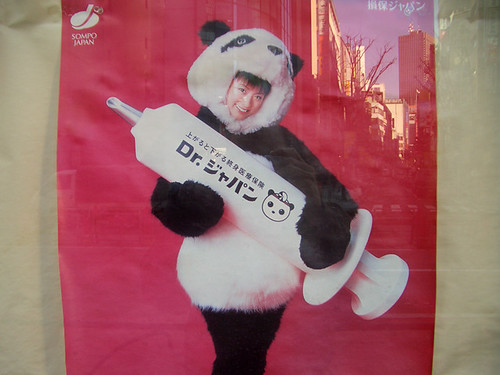
Little by little, I started to have enough of it all. Like when you eat too much chocolate and become sick and throw up. The fact that all spaces in the country are covered with big eyes and forced smiles started getting on my nerves, because sometimes you just want to eat without being greeted by someone who tells you how delicious that food is. And please, no more cute bunnies on ads -- I wanted calm public spaces, honest packaging, clean air, and open spaces with lots of natural light (something hard to attain in a cluttered shoebox like Tokyo).
Cake window in Nakano.
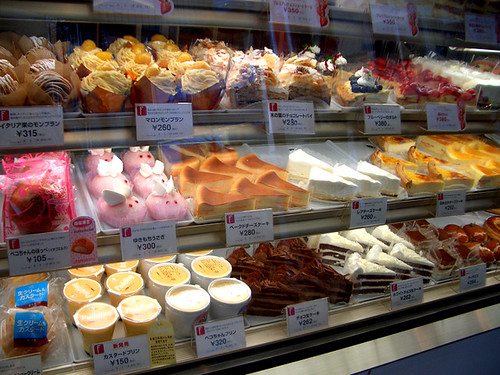 Cute little macarons, Tokyo 2005. SO ahead of the trend currently overflowing Denmark now, six years later.
Cute little macarons, Tokyo 2005. SO ahead of the trend currently overflowing Denmark now, six years later.
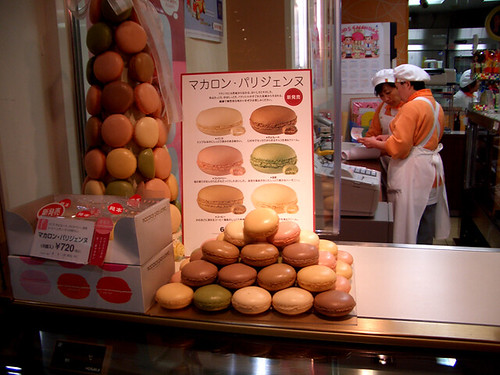
However, times
are changing and Japan is in serious state of flux. The economy is stalling, the aging population is rising high and since the Japanese have grown tired of sex and stopped making babies, it will be a gloomy future for the coming generations if the present doesn't revise and reshape the system and people's minds.
Which might also be why characters have started to be replaced with more Western influences in food packaging and shop design. Simple, clean looks with touches of Japanese but with more focus of quality, structure and order.
Qoo, orange sugar drink.
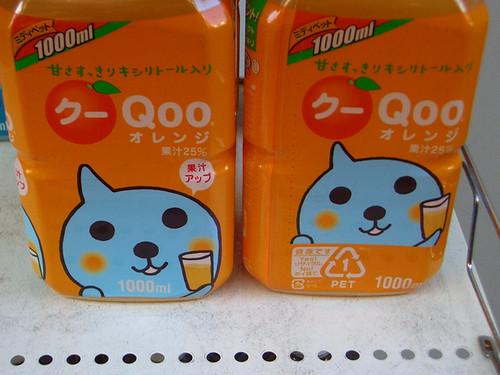 Ice cream display in Tokyo Zoo, also for grown-ups.
Ice cream display in Tokyo Zoo, also for grown-ups.
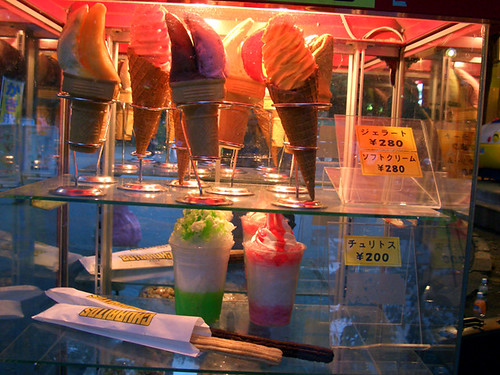 Plastic ice cream cones in cute pastel colours, Mt. Takao-san outside Tokyo.
Plastic ice cream cones in cute pastel colours, Mt. Takao-san outside Tokyo.
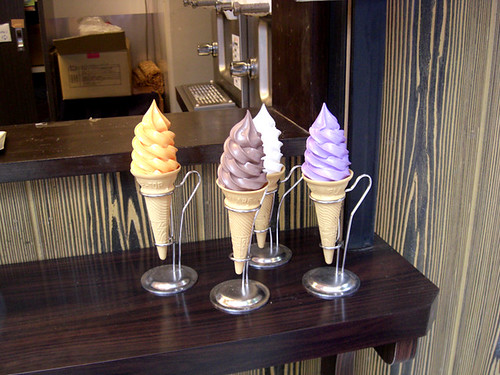 You can say what you want but this scoop of green tea ice cream is nothing short of cute.
You can say what you want but this scoop of green tea ice cream is nothing short of cute.
 Temple festival, people standing below giant pink and red banners with cute impersonations of the food they sell, like the squid wearing a "tenugui" (head wrap).
Temple festival, people standing below giant pink and red banners with cute impersonations of the food they sell, like the squid wearing a "tenugui" (head wrap).
 Mr. Donut, a big donut chain in Japan, is the essence of cute.
Mr. Donut, a big donut chain in Japan, is the essence of cute.
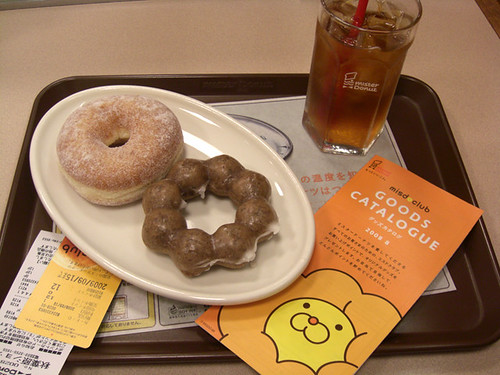 Harajuku cafe: you order a regular iced tea for grown upss, and you get your liquid sugar served in this ridiculous little pitcher.
Harajuku cafe: you order a regular iced tea for grown upss, and you get your liquid sugar served in this ridiculous little pitcher.
 Cute enough to make your heart melt. Arrrrgh!!
Cute enough to make your heart melt. Arrrrgh!!
I made it through my time in Tokyo, and I can thankfully appreciate the wackiness again. I will never abandon my love for
kawaii (as long as I can stay in a safe haven outside Japan), and I hope Japan will never abandon its love for it either. Where else would you go when you need a big pink rabbit to comfort your fears of the future?
 The kawaii (= cute) world of Japan is a very positive dimension of happiness, beauty, bunnies, rainbows and ribbons. And not just something that contains characters, but also an aesthetic approach that appeals to your heart, with a rather feminine touch and usually a soft design that makes you go, "Awwwww, that's so CUUUTE". Girls wearing aprons and a hat in bakeries, colourful pictograms on bus signs, the way a piece of chocolate cake is wrapped, bundled and delivered.
It's all cute -- like we're all in kindergarten playing post office or in a kids' TV programme. The process of doing something becomes an iconic action with all its instruments and processes, which is something the Japanese love: rules, regulations and prescribed actions so you're safe from doing something out of order.
And the images of kawaii always work as an eye opener for Scandinavian people living in their sterile, safe and generically-designed world. I could write a whole book on the kawaii phenomena. It's such a deep conversation topic if you really start digging in, but I'll just touch the surface here regarding characters and food in Japan.
In 2005 I quit my job, rented out my apartment and moved to Tokyo.
I was struck with feelings of ecstasy and wonder when stepping onto the streets of Japan for the first time. Could such a beautiful, positive world really exist in our time?
Little animals made of sugar. The shop sign calls them "birthday mascots".
The kawaii (= cute) world of Japan is a very positive dimension of happiness, beauty, bunnies, rainbows and ribbons. And not just something that contains characters, but also an aesthetic approach that appeals to your heart, with a rather feminine touch and usually a soft design that makes you go, "Awwwww, that's so CUUUTE". Girls wearing aprons and a hat in bakeries, colourful pictograms on bus signs, the way a piece of chocolate cake is wrapped, bundled and delivered.
It's all cute -- like we're all in kindergarten playing post office or in a kids' TV programme. The process of doing something becomes an iconic action with all its instruments and processes, which is something the Japanese love: rules, regulations and prescribed actions so you're safe from doing something out of order.
And the images of kawaii always work as an eye opener for Scandinavian people living in their sterile, safe and generically-designed world. I could write a whole book on the kawaii phenomena. It's such a deep conversation topic if you really start digging in, but I'll just touch the surface here regarding characters and food in Japan.
In 2005 I quit my job, rented out my apartment and moved to Tokyo.
I was struck with feelings of ecstasy and wonder when stepping onto the streets of Japan for the first time. Could such a beautiful, positive world really exist in our time?
Little animals made of sugar. The shop sign calls them "birthday mascots".
 Game arcade in Tokyo: giant transparent plastic blobs contain cute little mobile straps and figurines.
Game arcade in Tokyo: giant transparent plastic blobs contain cute little mobile straps and figurines.
 Mitaka, Tokyo: cute pink lamps hanging from all lamp posts.
Mitaka, Tokyo: cute pink lamps hanging from all lamp posts.
 The first few months in Tokyo went by like a breeze. As a character designer by profession, it was truly magical to experience every morning -- like walking to school on a fun ride in a cottoncandy dream. Every time you walk into a convenience store you are greeted by a happy characters on product after product. Cute and delicious: that's what the Japanese like.
Nakano, Tokyo: notice the big billboard for English school NOVA featuring a pink rabbit with a bird's beak.
The first few months in Tokyo went by like a breeze. As a character designer by profession, it was truly magical to experience every morning -- like walking to school on a fun ride in a cottoncandy dream. Every time you walk into a convenience store you are greeted by a happy characters on product after product. Cute and delicious: that's what the Japanese like.
Nakano, Tokyo: notice the big billboard for English school NOVA featuring a pink rabbit with a bird's beak.
 Girls dressed as the Pikachu in Harajuku.
Girls dressed as the Pikachu in Harajuku.
 There did not seem to be any deep meaning in walking around like this, except that they were just bored.
Super famous candy character Peko-chan ("peko-peko" means "starving" in Japanese).
There did not seem to be any deep meaning in walking around like this, except that they were just bored.
Super famous candy character Peko-chan ("peko-peko" means "starving" in Japanese).
 Connecting cuteness with food has the obvious reason of getting your attention. But it also tells a story about the brand, and who made it. In what ways should you appreciate specialty ramen from Osaka, or fluffy pastel ice cream? Many Japanese ad companies even throw in a character onto packaging, just because that's what you do in the ad world.
But the kawaii-ness also contains a dark side. A hollow, shallow shell of emptiness.
Cute girl, panda character and sickness. An example where the cuteness starts to get a little weird.
Connecting cuteness with food has the obvious reason of getting your attention. But it also tells a story about the brand, and who made it. In what ways should you appreciate specialty ramen from Osaka, or fluffy pastel ice cream? Many Japanese ad companies even throw in a character onto packaging, just because that's what you do in the ad world.
But the kawaii-ness also contains a dark side. A hollow, shallow shell of emptiness.
Cute girl, panda character and sickness. An example where the cuteness starts to get a little weird.
 Little by little, I started to have enough of it all. Like when you eat too much chocolate and become sick and throw up. The fact that all spaces in the country are covered with big eyes and forced smiles started getting on my nerves, because sometimes you just want to eat without being greeted by someone who tells you how delicious that food is. And please, no more cute bunnies on ads -- I wanted calm public spaces, honest packaging, clean air, and open spaces with lots of natural light (something hard to attain in a cluttered shoebox like Tokyo).
Cake window in Nakano.
Little by little, I started to have enough of it all. Like when you eat too much chocolate and become sick and throw up. The fact that all spaces in the country are covered with big eyes and forced smiles started getting on my nerves, because sometimes you just want to eat without being greeted by someone who tells you how delicious that food is. And please, no more cute bunnies on ads -- I wanted calm public spaces, honest packaging, clean air, and open spaces with lots of natural light (something hard to attain in a cluttered shoebox like Tokyo).
Cake window in Nakano.
 Cute little macarons, Tokyo 2005. SO ahead of the trend currently overflowing Denmark now, six years later.
Cute little macarons, Tokyo 2005. SO ahead of the trend currently overflowing Denmark now, six years later.
 However, times are changing and Japan is in serious state of flux. The economy is stalling, the aging population is rising high and since the Japanese have grown tired of sex and stopped making babies, it will be a gloomy future for the coming generations if the present doesn't revise and reshape the system and people's minds.
Which might also be why characters have started to be replaced with more Western influences in food packaging and shop design. Simple, clean looks with touches of Japanese but with more focus of quality, structure and order.
Qoo, orange sugar drink.
However, times are changing and Japan is in serious state of flux. The economy is stalling, the aging population is rising high and since the Japanese have grown tired of sex and stopped making babies, it will be a gloomy future for the coming generations if the present doesn't revise and reshape the system and people's minds.
Which might also be why characters have started to be replaced with more Western influences in food packaging and shop design. Simple, clean looks with touches of Japanese but with more focus of quality, structure and order.
Qoo, orange sugar drink.
 Ice cream display in Tokyo Zoo, also for grown-ups.
Ice cream display in Tokyo Zoo, also for grown-ups.
 Plastic ice cream cones in cute pastel colours, Mt. Takao-san outside Tokyo.
Plastic ice cream cones in cute pastel colours, Mt. Takao-san outside Tokyo.
 You can say what you want but this scoop of green tea ice cream is nothing short of cute.
You can say what you want but this scoop of green tea ice cream is nothing short of cute.
 Temple festival, people standing below giant pink and red banners with cute impersonations of the food they sell, like the squid wearing a "tenugui" (head wrap).
Temple festival, people standing below giant pink and red banners with cute impersonations of the food they sell, like the squid wearing a "tenugui" (head wrap).
 Mr. Donut, a big donut chain in Japan, is the essence of cute.
Mr. Donut, a big donut chain in Japan, is the essence of cute.
 Harajuku cafe: you order a regular iced tea for grown upss, and you get your liquid sugar served in this ridiculous little pitcher.
Harajuku cafe: you order a regular iced tea for grown upss, and you get your liquid sugar served in this ridiculous little pitcher.
 Cute enough to make your heart melt. Arrrrgh!!
I made it through my time in Tokyo, and I can thankfully appreciate the wackiness again. I will never abandon my love for kawaii (as long as I can stay in a safe haven outside Japan), and I hope Japan will never abandon its love for it either. Where else would you go when you need a big pink rabbit to comfort your fears of the future?
Cute enough to make your heart melt. Arrrrgh!!
I made it through my time in Tokyo, and I can thankfully appreciate the wackiness again. I will never abandon my love for kawaii (as long as I can stay in a safe haven outside Japan), and I hope Japan will never abandon its love for it either. Where else would you go when you need a big pink rabbit to comfort your fears of the future?




Comments (3)
Anders, the fact that there is NOVA in yr pictures dates this pre-2006 (they folded in 2007/8). I am feeling so nostalgic for Tokyo these days… especially for the Mr. Donut pon de leon aka butt beads. Thanks for reminding me of them.
I feel totally nostalgic too – especially in the spring. Let’s celebrate hanami together in our imagination. No, wait even better; let’s celebrate hanami when we hang in SF!
Wow, NOVA folded? Damn, I loved their pink bird rabbit. The photos are a mix from 2005-2009. Everything’s changing so rapidly in Tokyo – if I took a picture of a building today, it might be gone tomorrow…
I’m missing Mr. Donut. I think we still have their character plate which I got after eating lots of donuts and saving stamps from way back.